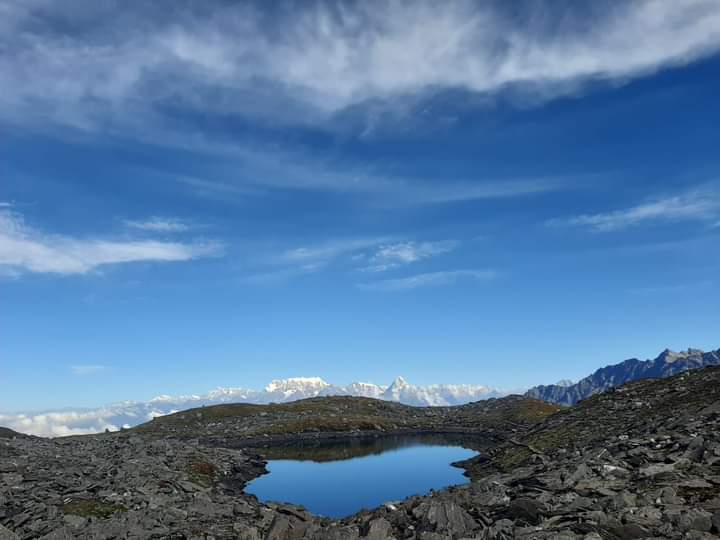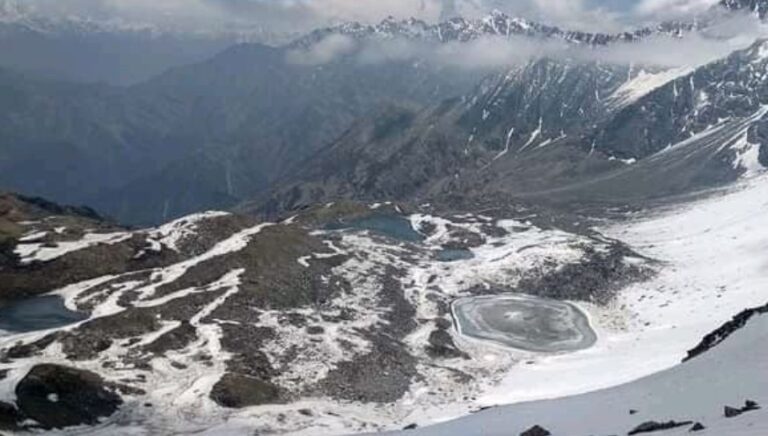
Sapt Kund Trek
Overview
The Sapt Kund Trek is a relatively lesser-known but stunning trek in the Garhwal region of Uttarakhand, India. The starting point of the trek is from Nandikund village near Joshimath. It takes you to Sapt Kund, the very name Sapt meaning seven and Kund meaning lake. Sapt Kund lake is a group of seven high-altitude glacial lakes located at the foothills of Huge Nanda and Ghunti peaks situated in the Chamoli district of the Himalayas.
This trek offers the chance to experience the rustic beauty of the Himalayas, snow capped peaks and stunning landscapes. As a part of the annual ritual, the villagers from surrounding villages visit this lake. It is believed that Lord Shiva lived here in this beautiful place.
The area is quite isolated, and trekkers need to be well prepared and go with a guided tour due to lack of infrastructure. This trek is ideal for trekkers as the it is an easy to moderate adventure and a rewarding journey through the Himalayan wilderness.
Trek Cost: Rs 35,000/- Per Person
• Region – Garhwal,Uttarakhand
• Altitude – 5000 mts
• Grade – Easy to Moderate adventure
• Type – Trekking Peak
• Best time to visit – April to May & Sep to Nov
• Duration – 6 nights / 7 days
Sapt Kund - Brief Itinerary
Day 1: Rishikesh -> Jhinji Village – 240 km by road
Day 2: Jhinji village -> Sangar camp – 8 km trek
Day 3: Sangar -> Cave camp – 8 km
Day 4: Cave Camp -> Simbe top/Saptkund lake & back – Cave camp – 15 km
Day 5: Cave Camp -> Jhinji village – 16 km
Day 6: Jhinji -> Bhyaltana – 3km trek, road 55 km
Day 7: Departure from Campsite after breakfast

Sapt Kund Trek - Detailed Itinerary
Day 1: Rishikesh to Jhinji Village (240 km by road)
Your journey begins with a scenic drive from Rishikesh to Jhinji Village, a remote and charming village nestled in the Garhwal Himalayas. The drive takes approximately 7-8 hours, covering a distance of 240 km. You will pass through beautiful landscapes, including river valleys, dense forests, and small hill towns. Upon arrival at Jhinji, settle into your accommodations and take some time to explore the village.
The rest of the evening is for relaxing, followed by dinner and a briefing for the trek ahead.
• Altitude: ~2,000 meters
• Drive Time: 7-8 hours
Day 2: Jhinji Village to Sangar Camp (8 km trek)
After breakfast, the Sapt Kund trek officially begins as you head towards Sangar Camp. The trail takes you through dense forests, crossing a few small streams and ridges along the way. The 8 km trek is moderate in difficulty, with some steep sections that offer rewarding views of the surrounding valleys. Sangar Camp is set in a peaceful meadow, where you will spend the night in tents, enjoying the tranquil beauty of the area.
• Trek Distance: 8 km
• Trek Time: 5-6 hours
Day 3: Sangar Camp to Cave Camp (8 km trek)
The second day of trekking takes you from Sangar to Cave Camp. The trail becomes more challenging as you gain altitude, with the landscape gradually changing from forests to alpine meadows. After trekking for around 8 km, you will reach Cave Camp, a natural shelter nestled amidst the rugged terrain. The campsite offers stunning views of the surrounding peaks, making it a perfect spot to rest and prepare for the ascent to Saptakund.
• Trek Distance: 8 km
• Trek Time: 5-6 hours
• Altitude: ~3,500 meters
Day 4: Cave Camp to Simbe Top/Saptakund Lake & back to Cave Camp (15 km trek)
After an early breakfast, you will begin your ascent to Simbe Top, a high-altitude ridge that offers panoramic views of the Garhwal Himalayas. From here, you will continue towards the mystical Saptakund Lakes, a group of seven alpine lakes. The trek is tough, covering 15 km round trip, but the sight of the serene lakes and the surrounding peaks makes it all worthwhile. After spending some time at the lakes, you will return to Cave Camp for the night.
• Trek Distance: 15 km (round trip)
• Trek Time: 8-10 hours
• Altitude: ~4,500 meters at Saptakund
Day 5: Cave Camp to Jhinji Village (16 km trek)
After a hearty breakfast, you will begin your descent back to Jhinji Village. The 16 km trek will take you through the same stunning landscapes you encountered on the way up, but the journey will feel different as you descend. Upon reaching Jhinji, you’ll enjoy a warm meal and rest after the long trek. This is your last night in the mountains, so take some time to reflect on the adventure.
• Trek Distance: 16 km
• Trek Time: 6-7 hours
Day 6: Jhinji Village to Bhyaltana (3 km trek, 55 km by road)
On this day, you’ll have a short 3 km trek from Jhinji to the nearest roadhead, where a vehicle will be waiting to transfer you to Bhyaltana, a campsite located 55 km away by road. The drive offers beautiful views as you descend from the higher altitude regions. Once at the campsite, enjoy your last evening surrounded by nature, with a bonfire and a hearty meal.
• Trek Distance: 3 km
• Drive Distance: 55 km
Day 7: Departure from Campsite after Breakfast
After a relaxing breakfast, your trek comes to an end. You can depart from the campsite and head back to your onward destination, taking with you memories of the serene Saptakund Lakes and the majestic Garhwal Himalayas.
Sapt Kund Trek - FAQs
1. What is the Sapt Kund Trek?
The Sapt kund trek is an adventurous and scenic hike to a group of seven alpine lakes, located in Chamoli district of the Garhwal Himalayas of Uttarakhand. It is known for its untouched beauty, with panoramic views of snow-capped peaks and lush green meadows.
2. How long is the trek?
The trek typically takes around 7-8 days, depending on the route and pace. It covers a distance of about 60-70 kilometers.
3. What is the best time to go?
The best time to trek Sapt Kund is between June and October. During this period, the weather is pleasant, and the trail is blooming with wildflowers.
4. How difficult is the trek?
The Sapt Kund Trek is considered a moderate to adventure. It involves steep climbs, rocky terrain and high altitudes, making it suitable for experienced trekkers.
5. What should I pack for the trek?
You should pack essentials like sturdy trekking shoes, warm clothing, a good-quality backpack, rain gear, water bottles, snacks, and a first aid kit. A sleeping bag and trekking poles are also useful.
6. Is there any accommodation on the trek?
There are no permanent accommodations on the trail. Trekkers usually camp in tents at designated spots.
7. Do I need a guide?
Yes, hiring a local guide is recommended for the Sapt Kund Trek. The trail can be tricky, with some sections not clearly marked, and a guide will ensure you stay on the right path and enjoy a safe trek.
8. How can I reach the starting point of the trek?
The trek starts from Ghat in the Chamoli district of Uttarakhand. You can reach Ghat by road from Rishikesh or Haridwar, which are well-connected to major cities like Delhi.
9. What is the altitude of Sapt Kund?
The highest point of the trek, near the Sapt Kund Lakes, is approximately 4,500 meters (14,763 feet) above sea level.
10. Are there any risks or challenges?
High altitude sickness is a possible risk due to the elevation. The weather can also change quickly, so it’s essential to be prepared for cold temperatures, especially at night.
11. What makes Sapt kund Trek special?
The trek offers a blend of untouched natural beauty, spiritual significance, and solitude. The lakes are serene, surrounded by pristine landscapes, and the views of towering peaks are breathtaking.
12. Is it a crowded trek?
No, the Sapt kund trek is relatively less explored compared to other popular treks in Uttarakhand, making it ideal for those seeking peace and solitude.
